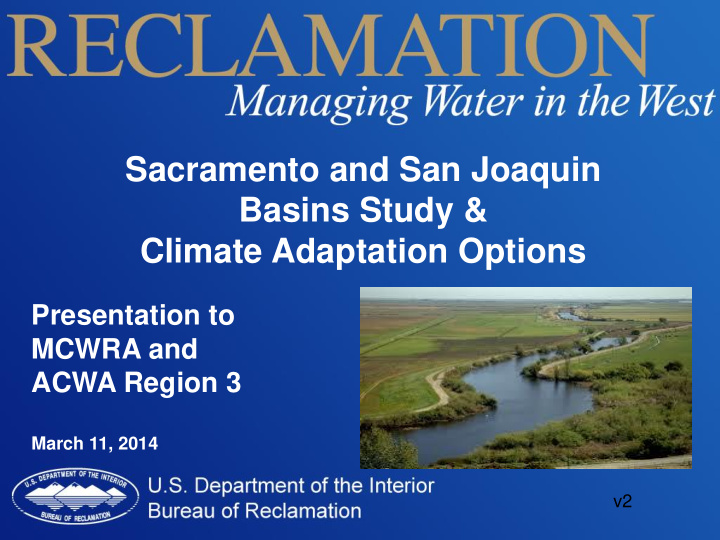



Sacramento and San Joaquin Basins Study & Climate Adaptation Options Presentation to MCWRA and ACWA Region 3 March 11, 2014 v2
WaterSMART – Basin Study Program Overview Basin Studies Authorized in SECURE Water Act, Public Law 111-11, Section 9503 • Established in 2010 by Secretary Salazar to… Analyze existing and future basin-wide water supplies and demands Identify potential climate impacts to supplies and demands Identify adaptive strategies in response to climate impacts
Basin Study Programs Activities under the Basin Study Program: • West-Wide Climate Risk Assessments • Basin Studies Basin Studies WaterSmart follow up Special Studies • Landscape Conservation Cooperatives
Basin Studies - Mandated Elements • Each Basin Study “will assess specific risks to water supplies in each major river basin including”: Changes in snowpack Changes in timing and quantity of runoff Changes in groundwater recharge and discharge • Any increase in: Demand for water due to increasing temperatures Rates of reservoir evaporation
Background The Sacramento and San Joaquin Basins Study
The Sacramento and San Joaquin Basins Study: • Sacramento River Basin • San Joaquin River Basin • Tulare Lake Basin
Climate Projections Sacramento and San Joaquin Basins Study: Phase 1- CMIP3 Climate Assessment
Sacramento-San Joaquin Climate Projections – Basins Implications Changes in Precipitation Patterns (warming= more precip as rain, less snow at elevation) Changes in Snowpack (earlier melt and runoff) Overall Precipitation: 1. Declines in the San Joaquin and Tulare Lake Basins 2. Uncertain in the Sacramento Basin Changes in Storm Track and Characteristics
Climate Impacts- Significant Droughts
Projected Precipitation Changes Simulated Changes in Decade-Mean Hydroclimate for the Sacramento River at Freeport 2020’s 2050’s 2070’s Hydroclimate Metric (Change from 1990) Mean Annual Precip. (%) -0.3 0.6 -2.7 Mean April 1st Snow Water Equiv. (%) -53.4 -75.9 -88.6 Mean Annual Runoff (%) 3.5 2.5 -3.6 Mean December - March Runoff (%) 9.0 13.6 11.0 Mean April - July Runoff (%) -11.1 -23.0 -36.1 SECURE Water Act, Section 9503 , Report to Congress, April, 2011
Basin Study Adaptation Strategies – Mitigating Climate Impacts Announcement for Adaptation Strategies and Options Starting April 1 st through Mid May Public, Stakeholders and Partner Agencies Options and Strategies Proposed – Analyzed in Basin Study Process See: http://www.usbr.gov/mp/SSJBasinStudy or contact Arlan Nickel (anickel@usbr.gov)
Adaptation Strategy: High Elevation Storage What is it? What makes it different? What are its advantages? How is it adaptable to climatic shifts? .
What is High Elevation Storage? Located in Headwater catchments of mainstem tributaries Western slopes of the Sierra Nevada/Southern Cascades Upstream of all existing terminal reservoirs
What is High Elevation Storage? Bowman Reservoir Gerle Creek Reservoir Ice House Reservoir Hell Hole Reservoir
What makes it different? First area to experience hydrologic shifts Largely unaffected by: Delta operations/water quality needs OCAP BiOp fish passage concerns ESA issues – anadromous fish Empty space reservation flood control
What makes it different? Smaller Watersheds, relatively isolated Steeper draining valleys Inflows – seasonal/non- perennial Distinct hydrograph – shorter refill period Excellent hydropower potential Snow dominated Receive first annual melt pulse
System-Wide Benefits From High Elevation Storage Downstream Flood Control Water Supply Benefits Provides opportunity to Local water supply relax flood space in reliability downstream reservoirs Augments regional water Buffers high inflow rates supplies to downstream reservoirs Enhances export and water Reduce peak flow events transfer opportunities on upper tributaries Reduce downstream levee failure risks
System Wide Benefits From High Elevation Storage Hydropower Instream Benefits Augment seasonal Large or small-scale instream flows hydropower projects Improve ability to meet Local revenue downstream generation source riparian/aquatic minimum flow needs Clean renewable energy Reduce flow ramping Use topographic extremes from characteristics – downstream reservoirs pumped storage opportunities?
System Wide Benefits From High Elevation Storage Delta Water Quality Reservoir Coldwater Enhancements Pool Assets Improve the ability to Increased managed meet downstream target Delta Inflow potential: temps. Salinity Standards Enhance ability for (Vernalis/X2) targeted species Habitat Protection flows recovery Enhance late summer/fall coldwater management
System-Wide Benefits From High Elevation Storage Enhance CVP/SWP Flexibility Recreational Benefits Increased Retention Water-related Upstream of CVP/SWP recreational activities Facilities: – Whitewater rafting – Enhance water yield – Fishing allocation – Boating – Increase later-season – Water craft transfer potential – Swimming/Camping – Relax downstream • Related Tourism flood reservations benefits – Lessen coldwater pool depletion
Adaptation Strategy: High Elevation Storage Concluding Comments: New era of water storage investigations Capture outflow during times of excess Integrates Water Supply & Flood Control Target the exact areas where climatic shifts will alter watershed response Multiple public benefits – Local Water Supply Reliability, Recreation, Environment, Flood Control Hydro Generation
High Elevation Storage Next Steps: As proposed adaptation strategy: -Request Partner agencies provide locations of Proposed/Potential/Planned High Elevation Reservoirs Reclamation will Inventory the High Elevation Sites proposed (need watershed location, elevation and approx. AF volume) Analyzed in the Sacramento and San Joaquin Basins Study - one of many climate adaptation strategies Contact: Arlan Nickel anickel@usbr.gov or (916) 978-5061 Basin Study Web Site: http://www.usbr.gov/mp/SSJBasinStudy
End of Presentation Supplemental Information Following
Recommend
More recommend